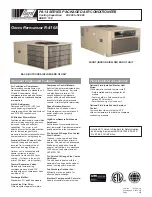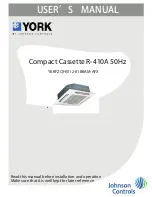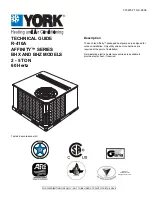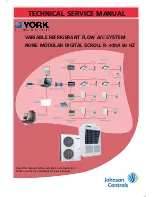
38
<Heating mode>
When 10 seconds have passed after the
compressor starts operation and the hot
adjustment mode has finished, the unit is
detected as abnormal when
condenser/evaporator pipe temperature is
not in heating range within 20 minutes.
Note 3) It takes at least 27 minutes to
detect abnormality.
Note 4) It excludes the period of defrosting
(Detection restarts when defrosting
mode is over)
Heating range : 3 deg
[
(TH2-TH1)
Error Code Meaning of error code and detection method
Cause
Countermeasure
P6
Freezing/overheating protection is
working
1
Freezing protection (Cooling mode)
The unit is in six-minute resume prevention
mode if pipe temperature stays under
-15
:
for three minutes, three minutes
after the compressor started. Abnormal
if it stays under -15
:
for three minutes
again within 16 minutes after six-minute
resume prevention mode.
<Frost prevention mode>
If pipe temperature is 2
:
or below
when 16 minutes has passed after com-
pressor starts operating, unit will start
operating in frost prevention mode which
stops compressor operation. After that,
when pipe temperature stays 10
:
or
more for 3 minutes, frost prevention
mode will be released and compressor
will restart its operation.
2
Overheating protection (Heating mode)
The units is in six-minute resume
prevention mode if pipe temperature is
detected as over 70
:
after the com-
pressor started. Abnormal if the temper-
ature of over 70
:
is detected again
within 10 minutes after six-minute
resume prevention mode.
P8
1
Slight temperature difference
between indoor room
temperature and pipe tempera-
ture thermistor
• Shortage of refrigerant
• Disconnected holder of pipe
thermistor
• Defective refrigerant circuit
2
Converse connection of
extension pipe (on plural units
connection)
3
Converse wiring of indoor/
outdoor unit connecting wire
(on plural units connection)
4
Defective detection of indoor
room temperature and pipe
temperature thermistor
5
Stop valve is not opened
completely.
(Cooling or drying mode)
1
Clogged filter (reduced airflow)
2
Short cycle of air path
3
Low-load (low temperature)
operation beyond the tolerance
range
4
Defective indoor fan motor
• Fan motor is defective.
• Indoor controller board is
defective.
5
Defective outdoor fan control
6
Overcharge of refrigerant
7
Defective refrigerant circuit
(clogs)
(Heating mode)
1
Clogged filter (reduced airflow)
2
Short cycle of air path
3
Over-load (high temperature)
operation beyond the tolerance
range
4
Defective indoor fan motor
• Fan motor is defective.
• Indoor controller board is
defective.
5
Defective outdoor fan control
6
Overcharge of refrigerant
7
Defective refrigerant circuit
(clogs)
8
Bypass circuit of outdoor unit
is defective.
(Cooling or drying mode)
1
Check clogs of the filter.
2
Remove shields.
4
Measure the resistance of fan motor's winding.
Measure the output voltage of fan's connector
(FAN) on the indoor controller board.
W
The indoor controller board should be
normal when voltage of AC 220~240V is
detected while fan motor is connected.
Refer to 8-7.
5
Check outdoor fan motor.
67
Check operating condition of refrigerant
circuit.
(Heating mode)
1
Check clogs of the filter.
2
Remove shields.
4
Measure the resistance of fan motor's
winding.
Measure the output voltage of fan's connector
(FAN) on the indoor controller board.
W
The indoor controller board should be
normal when voltage of AC 220~240V is
detected while fan motor is connected.
Refer to 8-7.
5
Check outdoor fan motor.
6
~
8
Check operating condition of refrigerant
circuit.
Abnormality of pipe temperature
<Cooling mode>
Detected as abnormal when the pipe tem-
perature is not in the cooling range 3 min-
utes later of compressor start and 6 min-
utes later of the liquid pipe is out of cooling
range.
Note 1) It takes at least 9 min. to detect.
Note 2) Abnormality P8 is not detected in
drying mode.
Cooling range : -3 deg
]
(TH2-TH1)
TH2: Liquid pipe temperature
TH1: Intake temperature
1
~
4
Check pipe temperature with room
temperature display on remote
controller.
23
Check converse connection of extension
pipe or converse wiring of indoor/outdoor
unit connecting wire.
1
Wrong wiring of indoor/outdoor
connecting wire
2
Reversed phase
3
Protection device is working
4
Damaged outdoor coil thermis-
tor
Abnormality in outdoor unit
1
Check the indoor/outdoor connecting wire.
2
Change the connection of electric wiring.
3
Check the protection device.
4
Measure the resistance of the outdoor coil
thermistor. If the resistance is normal,
replace the outdoor controller board.
OC360--2.qxp 06.2.24 1:55 PM Page 38
















































